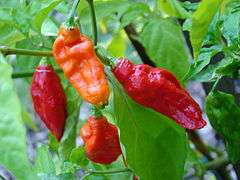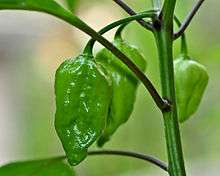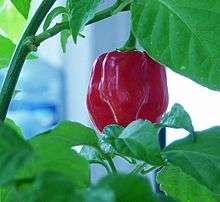Scoville scale


The Scoville scale is a measurement of the pungency (spiciness/heat) of chili peppers and other spicy foods, as recorded in Scoville Heat Units (SHU) based on the concentration of capsaicin.[1][2] Capsaicin is one of many related pungent compounds found in chili peppers, collectively called capsaicinoids.[3] The scale is named after its creator, American pharmacist Wilbur Scoville, whose 1912 method is known as the Scoville organoleptic test.[1][4]
In modern times, high-performance liquid chromatography is used to determine the pungency.[1] The older method is a subjective measurement dependent on the capsaicin sensitivity of testers, and so is not a precise or accurate method to measure capsaicinoid concentration.[1][4][5]
Scoville organoleptic test
In the Scoville organoleptic test, an exact weight of dried pepper is dissolved in alcohol to extract the heat components (capsaicinoids), then diluted in a solution of sugar water.[6][7][8] Decreasing concentrations of the extracted capsaicinoids are given to a panel of five trained tasters, until a majority (at least three) can no longer detect the heat in a dilution.[7][8][9] The heat level is based on this dilution, rated in multiples of 100 SHU.[7]
A weakness of the Scoville organoleptic test is its imprecision due to human subjectivity, depending on the taster's palate and number of mouth heat receptors, which varies widely among people.[9] Another weakness is sensory fatigue;[9] the palate is quickly desensitized to capsaicinoids after tasting a few samples within a short time period.[7] Results vary widely (up to ± 50%) between laboratories.[8]
Pungency units

Since the 1980s, spice heat has been measured by high-performance liquid chromatography (HPLC), which measures the concentration of heat-producing chemicals, such as capsaicin.[6] HPLC results permit the measurement of a substance’s capacity to produce perceived heat ("pungency"). This method yields results in American Spice Trade Association (ASTA) "pungency units", which are defined as one part capsaicin per million parts dried pepper mass. Quoting from one review: "Conventional methods used in determining the level of pungency or capsaicin concentration are using a panel of tasters (Scoville Organoleptic test method). ... Pepper pungency is measured in Scoville Heat Units (SHU). This measurement is the highest dilution of a chile pepper extract at which heat can be detected by a taste panel (Bosland et al., 2007)."[11] According to another source, "the most reliable, rapid, and efficient method to identify and quantify capsaicinoids is high-performance liquid chromatography (HPLC); the results of which can be converted to Scoville Heat Units by multiplying the parts-per-million by 16."[5]
Scoville ratings
Considerations
Since Scoville ratings are defined per unit of dry mass, comparison of ratings between products having different water content can be misleading. For example, typical fresh chili peppers have a water content around 90%, whereas Tabasco sauce has a water content of 95%.[12] For law-enforcement-grade pepper spray, values from 500,000 up to 1 million SHU have been mentioned,[13] but the actual strength of the spray depends on the dilution.[1]
Numerical results for any specimen vary depending on its cultivation conditions and the uncertainty of the laboratory methods used to assess the capsaicinoid content. Pungency values for any pepper are variable, owing to expected variation within a species—easily by a factor of 10 or more—depending on seed lineage, climate (humidity is a big factor for the Bhut Jolokia; the Dorset Naga and the original Naga have quite different ratings), and soil (this is especially true of habaneros). The inaccuracies described in the measurement methods above also contribute to the imprecision of these values.[8]
Capsicum peppers
Capsicum chili peppers are commonly used to add pungency in cuisines worldwide.[5] Subjective sensory feedback from people experienced with tasting hot chili peppers indicates five possible categories related to perceiving chili heat and the corresponding Scoville units: 1) development of heat sensation over time, 2) duration, 3) location (lips, mouth, throat, stomach), 4) sensation of heat, and 5) intensity (specifically related to Scoville units).[5] The range of pepper heat reflected by a Scoville score is from 100 or less (sweet peppers) to over 3 million (Pepper X) (table below; Scoville scales for individual chili peppers are in the respective linked article).
| Scoville heat units | Peppers |
|---|---|
| 800,000 to 3,200,000 | Pepper X, Carolina Reaper, Dragon's Breath, Naga Morich[14] |
| 350,000 to 800,000 | Red Savina pepper, Chocolate habanero |
| 100,000 to 350,000 | Habanero, Scotch Bonnet |
| 10,000 to 100,000 | Malagueta pepper, Cayenne pepper |
| 1,000 to 10,000 | Guajillo pepper, Jalapeño |
| 100 to 1,000 | Banana pepper, Cubanelle |
| 0 to 100 | Bell pepper, Pimento |
Capsaicinoids

The class of compounds causing pungency in plants like chili peppers is called capsaicinoids, which display a linear correlation between concentration and Scoville scale, and may vary in content during ripening.[15]
| Scoville heat units | Chemical |
|---|---|
| 16,000,000,000 | Resiniferatoxin |
| 5,300,000,000 | Tinyatoxin |
| 16,000,000 | Capsaicin, Dihydrocapsaicin[16] |
| 9,200,000 | Nonivamide[16] |
| 9,100,000 | Nordihydrocapsaicin[16] |
| 8,600,000 | Homocapsaicin, Homodihydrocapsaicin[16] |
| 160,000 | Shogaol |
| 100,000 | Piperine |
| 60,000 | Gingerol |
| 16,000 | Capsiate |
References
- 1 2 3 4 5 Twilight Greenaway (10 January 2013). "How Hot is That Pepper? How Scientists Measure Spiciness". Smithsonian.com, US Smithsonian Institution. Retrieved 17 December 2017.
- ↑ Peter, KV, ed. (2001), Handbook of Herbs and Spices, 1, CRC Press, p. 120, ISBN 0-8493-1217-5
- ↑ Mazourek M, Pujar A, Borovsky Y, Paran I, Mueller L, Jahn MM (2009). "A Dynamic Interface for Capsaicinoid Systems Biology" (PDF). Plant Physiology, Bioinformatics. 150: 1806–1821. doi:10.1104/pp.109.136549. PMC 2719146.
- 1 2 Scoville, Wilbur (May 1912). "Note on Capsicums". Journal of the American Pharmaceutical Association. 1 (5): 453–454. doi:10.1002/jps.3080010520.
- 1 2 3 4 Guzmán, I; Bosland, P. W (2017). "Sensory properties of chili pepper heat - and its importance to food quality and cultural preference" (PDF). Appetite. 117: 186–190. doi:10.1016/j.appet.2017.06.026. PMID 28662907.
- 1 2 Kleiman, Dena (November 8, 1989). "Rating Hot Peppers: Mouth vs. Computer". The New York Times. Retrieved 2014-11-02.
- 1 2 3 4 Peter, K. V. (2012). Handbook of Herbs and Spices. Elsevier Science. p. 127. ISBN 978-0-85709-5671.
- 1 2 3 4 Tainter, Donna R.; Anthony T. Grenis (2001). Spices and Seasonings. Wiley-IEEE. p. 30. ISBN 0-471-35575-5.
Interlab variation [for the original Scoville scale] could be as high as +/−50%. However, labs that run these procedures could generate reasonably repeatable results.
- 1 2 3 Barry-Jester, Anna Maria (October 15, 2014). "Rating Chili Peppers On A Scale Of 1 To Oh Dear God I'm On Fire". FiveThirtyEight. Retrieved 2014-11-02.
- ↑ DeWitt, Dave; Bosland, Paul W. (2009). The Complete Chile Pepper Book. ISBN 978-0-88192-920-1.
- ↑ Stoica R, Moscovici M, Tomulescu C, Băbeanu N (2016). "Extraction and analytical methods of capsaicinoids - a review" (PDF). Scientific Bulletin. Series F. Biotechnologies. XX: 93–96. ISSN 2285-1364.
- ↑ USDA nutrient database for Peppers, jalapeño, raw (92% water content); Peppers, hot chile, red, raw (88% water content); Red Tabasco sauce (95%)
- ↑ "Chemical hazards in law enforcement". The Police Policy Studies Council. Retrieved 2009-02-09.
Most law enforcement sprays have a pungency of 500,000 to 2 million SHU. One brand has sprays with 5.3 million SHU.
- ↑ "Some Like It Hot: Dorset's Ultra-Hot Chillies". Archived from the original on 19 November 2012. Retrieved 25 August 2010.
- ↑ Nagy, Z; Daood, H; Ambrózy, Z; Helyes, L (2015). "Determination of Polyphenols, Capsaicinoids, and Vitamin C in New Hybrids of Chili Peppers". Journal of Analytical Methods in Chemistry. 2015: 102125. doi:10.1155/2015/102125. PMC 4606152. PMID 26495153.
- 1 2 3 4 Govindarajan, Sathyanarayana (1991). "Capsicum — Production, Technology, Chemistry, and Quality. Part V. Impact on Physiology, Pharmacology, Nutrition, and Metabolism; Structure, Pungency, Pain, and Desensitization Sequences". Critical Reviews in Food Science and Nutrition. 29 (6): 435–474.
External links
- Wilbur Scoville profile on NNDB